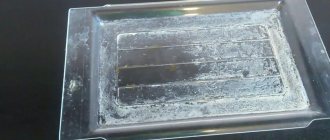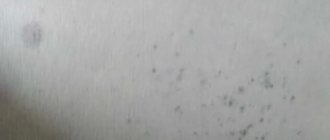There is probably not a single person who has not at least once in his life encountered the following problem: putting a stain on his clothes (no matter what). You could write a collection of essays about how to remove various stains from clothes. But today's article will be devoted to talking about how to remove white spots from black. Of course, stains are more clearly visible on white and colored fabric, but don’t think that black fabric doesn’t get dirty at all. It gets dirty, and how. But how to remove stains from it? The methods are slightly different from those that should be used when removing stains from white and colored items.
Stage one
So let's get started.
First, you need to prepare the product: you need to check how it will react to the stain removers that you are going to use. It is best to first test it on some unnecessary thing made from the same material. If you don't do this, you risk simply ruining the product. It’s also worth determining what actually stained your clothes. It would take a long time to list all types of stains; we won’t do that.
The most important tip: do not use hot water to wash a stained item (otherwise you will only set the stains and not remove them). So wash your clothes at 40 degrees (but not higher). And be sure to treat soiled items only from the inside out - this way, after cleaning, there will be no streaks left on the items. And after washing and removing the stain, it is best to dry things on a line on the balcony or in the open air (it is not advisable to use a battery, since drying too quickly can again lead to the appearance of streaks). We briefly list all the means that you can use to remove white stains from black clothes:
Why do stains appear on things after washing in the washing machine?
White streaks, stains or residue on clothing are generally not a serious problem because they can be easily removed. However, additional work takes time and effort, so it is better to take action right away and do everything right. Moreover, there are few reasons why stains appear on things after washing in a washing machine.
Too much powder
Some housewives believe that the more detergent, the cleaner the clothes will become, and therefore they sprinkle the powder with all their hearts. Unfortunately, they get the opposite result. After all, when there is too much detergent, it is more difficult to rinse it out. As a result, it remains inside the fibers of the fabric, forming whitish stains.
The limit of items in the drum has been exceeded
Each machine is designed for a certain weight of dry laundry. If you overload the tank, the washing powder will be compressed between the layers, and the water will not be able to completely dissolve it.
White stains also remain when using a special powder dispenser. Some of the detergent will get into the creases of things, which will make it difficult to dissolve. Therefore, it is recommended to place the capsule on top of the laundry, closer to the back wall of the tank.
Note! It is especially dangerous to exceed the washing powder limit in high-efficiency washing machines. They provide for economical water consumption, so there is not enough water to completely dissolve overdoses of the product.
Wrong rinse mode
If you use the economy cycle, there may not be enough water to completely remove any traces of detergent. An extra rinse will be required to get the items clean.
Hard water for washing
If the machine does not have a filtration system or it is faulty, then white streaks will appear on the clothes after each wash.
It's all about the impurities contained in the water: they react with the components of detergents, forming new compounds. These are the culprits of the whitish coating.
Adding powder to the washing machine drum
Some housewives prefer to sprinkle the powder directly onto the laundry, ignoring the tray. And thereby provoke the appearance of stains on things. After all, before you start washing, the machine dissolves the product and delivers it to the laundry tank, evenly distributing it over the items.
If you sprinkle dry powder on top of things, it will not be able to completely dissolve. In addition, it is possible that the soaked product will clump together or be compacted into the material under strong pressure of water. It will be very difficult to remove it from there: it will require repeated rinsing, or even washing.
It is also possible that an excess amount of powder will discolor the area where it has accumulated. As a result, whitish spots or stains will form, and the item will be damaged.
Products for removing white stains from black clothes
- You can use regular table salt with the addition of ammonia. This product is suitable if your clothes are made of cotton or linen. Dissolve one spoon of salt in warm water, add one teaspoon of ammonia to it. Use this solution to wipe the stain, wait 15 minutes, and then rinse the product or wash it.
— to remove stains from silk products, you can again use regular salt. Add one teaspoon to a glass of warm water (the damaged item must first be soaked in soapy water for 10 minutes), wipe the stain with this solution, wait another 10 minutes and wash.
- For wool products, regular laundry soap is suitable. You need to lather it well in hot water, thoroughly lather the stains, soak the item for an hour and a half, and then wash it.
- ammonia. It can simply be added when washing items by hand.
How can you prevent white streaks from appearing?
If a whitish coating forms on things too often, it means that mistakes were made when washing. The following recommendations will help you avoid them:
- choose the right detergent according to the type of fabric;
- carefully observe the dosage of the powder, do not use in excess;
- do not overload the drum with laundry;
- regularly clean the powder tray and drainage system;
- install a water purification filter on the tap or in the car;
- use water softeners with every wash;
- Do not use products containing bleach to wash dark colored items with unstable coloring.
Thus, there are several reasons why white marks may form on clothes. If you avoid them, your homework will be much easier, and your things will always look neat.
Old stains
Old stains are best dealt with using regular table salt. It is necessary to thoroughly rub it into the contaminated areas, leave the item for 12 hours, and then rinse. If you need to remove the stain urgently, then soak it for an hour in a solution of table salt, and then rinse thoroughly. An excellent remedy for removing white stains from black clothes is lemon juice. Use a cotton swab to apply it. Moisten the contaminated area with lemon juice, and then thoroughly wash the soiled clothes using laundry soap. But this method will only work if the stain is fresh. It is best to get rid of old stains using ammonia. This may seem strange, but to get rid of stains, you can use vodka. Just wipe the stained areas on your clothes with it, leave the product for 30-40 minutes, and then wash it thoroughly. But all these recommendations are only suitable if the stain is fresh. But what if it’s outdated? Then you need to do things a little differently.
- Prepare a solution of hydrogen peroxide, dishwashing detergent and baking soda. Mix all the above ingredients thoroughly, apply them to the soiled areas, leave for several hours, and then wash the item thoroughly.
- You can also use ammonia. Just wipe the dirty area with it and leave it like that for a few minutes.
- Hydrogen peroxide and aspirin are excellent. Carefully crush 2 aspirin tablets, add a little water, mix everything and apply to the product. Then you wait 2 hours and rinse the item, be sure to wipe the stained area with hydrogen peroxide and rinse again.
Everything we talked about is easy to do. It is not at all necessary to buy any super products for cleaning clothes. Everything described is in every home.
Remove powder from colored clothing
Powder is an indispensable assistant in our care for things, but it can also become a little traitor. It can cause stains on freshly washed clothes. How to remove powder stains from colored clothes?
There are several techniques for this. It’s worth starting with the fact that this is necessary immediately, before you just take the item out of the machine. Load the spoiled food back into the drum and rinse again. Then you can do it a second time.
If you washed colored laundry by hand, then you need to place it in a basin of water for some time so that it softens.
Then add shavings of laundry soap and a little vinegar. Rinse thoroughly.
This should help, even if not the first time.
You can also use boiling water, but this method is only suitable for fresh stains. Pour a stream of fresh boiling water over the stain - that's all the advice.
There is another option, but it requires a lot of attention. This stain removal option will require bleach. It must be carefully applied directly along the radius of the stain. The most important thing is to wash it off in time, otherwise you will get another problem. And we will write about it below.
This is interesting: What means can you use to remove grease stains from jeans?
Overdone with funds
Exceeding the recommended dose of powder also leads to white-yellow deposits. If there is too much product in the water, it will not be rinsed out and will penetrate deep into the fabric. As a result, foreign residue will remain on things.
When adding detergent to the machine, you must strictly follow the dosage given on the packaging!
Exceeding the norm is especially dangerous when operating high-efficiency washing machines. Such units use less water for washing and rinsing, which makes the process of dissolving the powder more difficult. It is better to underestimate the recommended dosage and regularly clean the dispenser (if it is automatic).
Sweat
Sweat contains a high concentration of salt. Just as the salt from antiperspirants can stain dark clothing, excessive sweating can leave a ring of white salt on dark clothing. You will often notice dark shirts with white rings around the collar after sweating a lot. Typically this salt will wash out during a regular wash cycle, but you can soak the material in cold water to dissolve the salt if the stains are difficult to remove.
Restore fabric using dye
If partial staining of colored items is too noticeable, then the color of the affected items is completely changed. Dyes are used for this purpose. First, the product is dissolved according to the instructions. For more uniform coloring, add table salt.
The matter is either exposed to a hot solution (+40…+60°C) or boiled. Then leave in the liquid for another 20-30 minutes. After this, rinse in water with the addition of acetic acid.
Hydrogen peroxide
Yellowish stains that have appeared recently and occupy a small area of matter can be removed with hydrogen peroxide. You can buy the product at any pharmacy without a prescription. It is not only an antiseptic, but also a high-quality bleach.
In addition to the peroxide itself, you will need a cotton pad and a bar of laundry soap. All traces of a yellow tint should be thoroughly wiped with a cosmetic disc generously soaked in the solution. Then lather and wash. The item should be rinsed under cold running water. If streaks remain, the manipulation must be repeated.
Preparation
Manufacturers can use a variety of dyes to dye textile fibers, so it is difficult to predict their resistance to certain substances. Before washing white stains on black clothes, you should test the product on an inconspicuous area. Materials react differently to processing, which increases the risk of further damage to clothing.
Light stains on dark fabric can be of different origins:
- from deodorant;
- decorative cosmetics;
- sweat;
- glue, etc.
It is worth considering that hot water will only fix the contamination. Regardless of the material, it is advisable to wash such items at a temperature no higher than 40 degrees.
You can avoid the appearance of streaks and new stains when cleaning soiled areas if you process the fabric from the wrong side.
After cleaning, it is advisable to leave the clothes to dry naturally, away from heat sources. Drying too quickly can cause light streaks to appear on items.
Baking soda
Sodium bicarbonate also does a good job of removing stubborn stains that have an unpleasant yellow or brown tint. This is the most affordable remedy, because baking soda can be found in any housewife’s kitchen. To prepare the composition you will need 20-25 g of powder. It is diluted with water to a thick puree and applied to damaged areas. Leave for 1-2 hours, then rinse with cold water.
The nuances of cleaning textiles of various colors
The choice of product for treating fabric depends on its color. Recommendations to pay attention to:
- White matter can be cleaned with aggressive compounds. She is not afraid of contact with acetone, solvent, vinegar and alcohol. Such items are soaked in bleach for as long as possible, but try to avoid using fat-based products, such as kerosene, vegetable oil or gasoline. After applying them, noticeable yellow spots will remain on the white item.
- Black fabric needs careful cleaning. To remove stains from it, gentle products are used. It is best to use substances that help fix the color: alcohol, vinegar, saline solution. Black items should be washed and soaked in cool water for a short period of time.
- Colored matter also does not tolerate contact with aggressive substances. Their choice largely depends on the strength of the dye. The weaker its adhesion to the surface, the lower the concentration of the cleaning agent should be. Such products are washed in warm, but not hot water. The average soaking time is 1 hour.
Helpful information
Tips to follow when removing stains from fabric:
The fight against old stains should not be put off until later; treatment begins immediately after contamination is detected, so it can be dealt with without the use of aggressive compounds;- stains should be removed from the edge to the center so as not to stain the clean area;
- For processing, use only white material: napkins or cotton pads, so when in contact with chemicals, the pigment from the colored rag can transfer to the surface being cleaned;
- Before you begin processing, you need to study the information indicated on the product label; different fabrics have their own care rules.











